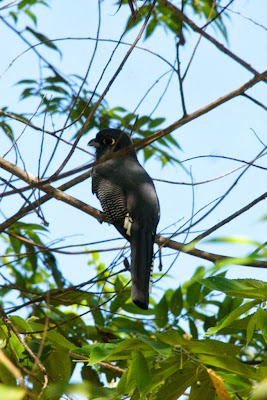One thing that I have come to realize through the process of letting go has been that the relationships forged between the people, birds, communities, ecosystems and even the data can all carry on without the physical structure tethering them to Playa Azul. Here are some photos of my time there from Jan 11, 2014-January15th
The view of the Institute and grounds as seen from the street with one's back to the Tarcoles River.
The sign that I painted in 2001, really doesn't look all that bad for not having been touched up.
The neighbor's house, and typical of the town.
The view from the front of the Herman Institute, looking out at the Tarcoles River and Gerardo Montero who has gill-netted in the mouth of the river for over 50 years.
Gerardo Montero, father of my friend and Bird Guide Luis Campos, and to Xinia Campos the caretaker of T.H.I.B.S. for the last 11 years. Look at his feet.
Some plants and a wonderful statue that has been with the property through many incarnations...
This is Pipo and his oxen. He is in his 70's and delivered the stones and gravel used in the construction of the Institute. He still fills his cart mostly on his own, I doubt he'd rather be watching "Oprah".

The Scarlet Macaw, once a dwindling population has been on the upswing for more than 10 years with the reduction in nest predation by pet smugglers

Don Javier and his family, the new owners of the Institute property in Playa Azul. Wonderful people
Pelicans around the fishing boats in Tarcoles
You'd Howl too if you were sitting on your nuts! This was one of a troop of 4 Howler Monkeys that came through the yard to say goodbye on my last day in Playa Azul.
A Black-headed Trogon in the town of Tarcoles
SUnsets in Playa Azul are almost always breathtaking, as the sun dips below the tip of the Nicoya Peninsula. This Woodstork made this sunset exceptional!
A Black Ctenosaur , an iguanid that is very common in Costa Rica. Known as "garrobo" locally, it is also relished as a wild food source.
I got to go to Carara on Tuesday the 14th. I birded the River trail in the morning and saw 91 species of bird. It was a wonderful morning punctuated by a flyover of two male Yellow-billed Cotingas!
White-faced Capuchin monkeys are really common in Carara National Park. These guys were raiding a wild banana grove
A Chestnut-backed Antbird shot at 1/6th of a second. I don't like to use a flash to photograph birds for the most part.
The largest click beetle that I have ever seen.
My friend Juan prepares a long line set over 3 kilometers long for Red Snapper
Scarlet Macaws are often in the nearby towns and villages eating beach almonds.





.jpg)


.jpg)








Beautiful shots Drew. Thanks for bringing me back to the time you brought me down. I loved it.
ReplyDeleteGreat stuff Drew. Wish I could have visited sometime. See you soon.
ReplyDeleteThanks Drew, It brings back some memories for me. I was serious when I suggested a Hermanite reunion sometime. I think we should make it happen.
ReplyDelete